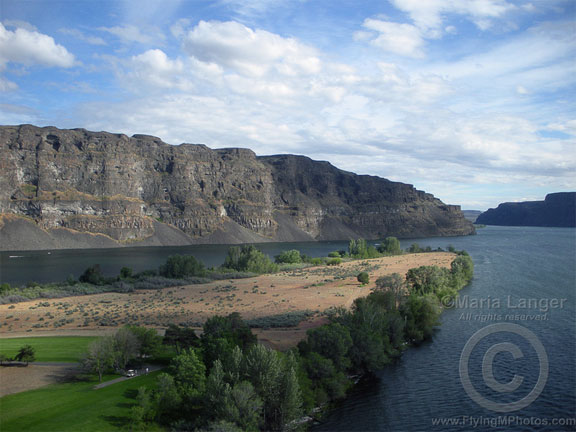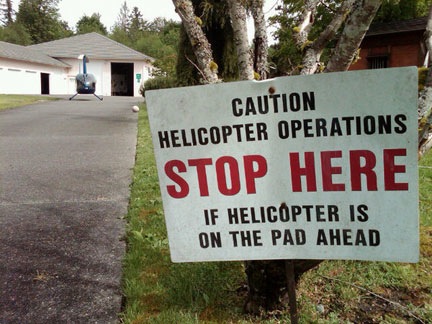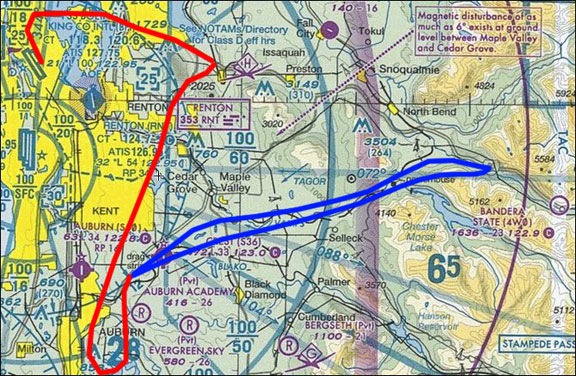A quick look at my current RV living experience.
I’m back in Quincy, WA for the third consecutive year, gearing up for cherry drying season. On Saturday, when my first contract starts, I’ll be literally stuck here in town, waiting for it to rain so I can spring into action and fly for my clients. And if the weather stays the way it has been for the past week, I’ll be doing an awful lot of flying.
The previous two years, I lived in a 22-foot “hybrid” RV that included a hard-sided camper shell with a single slide out and two pop-up camper type beds. When I first bought this camper, I thought it would be perfect for this kind of mission. But I didn’t foresee the need to write three books in it or an excruciating back problem that would last a month. I realized that when you have to live in an RV for three to four months out of the year — with a parrot, no less — you’d better have a pretty damn comfortable RV.
So I bought what I considered to be “the perfect RV.” While I don’t really think it’s “perfect,” I still believe that it’s as close as I’m likely to get unless I have one built to my exact specifications — which is not an option. This RV has plenty of space, as well as comfortable places to sit. Best of all, I don’t have to work in the same space where I try to take my meals.
But I’m getting ahead of myself here. @Miraz wanted to know more about my setup here, so let me go into that a bit.
The Campground
I’m living at the Colockum Ridge Golf Course. A weird thing about golf courses out here is that they often include a limited number of RV parking spaces. Colockum Ridge (formerly Quincy Golf Course), which is now owned and operated by the Port of Quincy, is one of those places. It has five or six full hookup sites — that means sites with water, electricity, and sewer hookups. The sites are not far from the main office, between a wide driveway area and a narrow path out to the golf course. One of the greens is about 50 yards from the last spot. The golf course also has a handful of water and electric only spots. Those are on the other side of the wide driveway, near a well-trafficked road.
For the first two years I was here, the monthly rate for a full hookup spot was $300. I thought that was a pretty good deal. The first year, all the full hookup spots were occupied by me and construction workers for a pair of data centers being built in Quincy. Last year, I was the only long term occupant. This year, in an effort to attract more long term occupants, they dropped the monthly rate to only $200. This is a steal. (Oddly, I was worried the rate might go up; never expected it to go down.) The only drawback to the lower rate is that they’ve apparently attracted the owner of a junky old trailer who seems to be using his site as a weekend getaway. (Sometimes a higher rate is good to keep the riffraff out.)
 Although the spots are small, they do have well-kept lawns. Parking is on a gravel spot that you need to back into; that gravel area is surrounded by railroad ties on three sides to keep it separate from the grass. The spots aren’t exactly level — as I found out this year — but they’re not far off. I surprised myself with my ability to get the trailer into the spot; it was the first time I’d every done any serious backing up and it didn’t take more than a few tries to get it into place.
Although the spots are small, they do have well-kept lawns. Parking is on a gravel spot that you need to back into; that gravel area is surrounded by railroad ties on three sides to keep it separate from the grass. The spots aren’t exactly level — as I found out this year — but they’re not far off. I surprised myself with my ability to get the trailer into the spot; it was the first time I’d every done any serious backing up and it didn’t take more than a few tries to get it into place.
There are a few drawbacks of living here:
- They start tending to the grass not long after dawn. That means there are lawn mowers running as early as 5:30 AM. This doesn’t bother me because I’m usually awake by then.
- Because the RV spots are near the office and the office is at the intersection of two major roads, traffic noise — especially trucks slowing down to make one of the stop signs — can be a bother. In my old camper, it actually kept me up at night. In my new one, I don’t hear much unless the windows are open.
- Golf carts and the odd piece of maintenance equipment drive right past the back window of my RV all day long every day. Before I moved the trailer 2 feet forward to get the left wheels on blocks (for leveling), they’d be within arm’s reach of my back window. Now they’re 2 feet farther away.
- The sites really are tiny — although I suppose they’re about the same as the standard RV parking lots selling themselves as RV parks or “campgrounds” these days. My front slide-out actually hangs over into the parking spot next to mine, which is on a weird angle. There’s nothing I can do about it.
But there’s plenty good about living here:
- They allow me to have my mail delivered to their address. So I can get mail and packages delivered to me here. I’m also the one who collects the mail daily; apparently no one else ever checks it. The first time I checked it, the box was absolutely stuffed. The mail carrier must like me.
- This year, I have a picnic table, which will come in handy (if it ever stops raining for more than a few hours) for using my new barbecue grill, eating out, and getting Alex the bird outside for a while.
 I have some nice views. My “office” window looks out on an idyllic view of trees, a picnic table, and the golf course. There are also birds — primarily robins — digging in the grass for worms throughout the day. Soon they’ll bring their chicks.
I have some nice views. My “office” window looks out on an idyllic view of trees, a picnic table, and the golf course. There are also birds — primarily robins — digging in the grass for worms throughout the day. Soon they’ll bring their chicks.- My helicopter is parked at an ag strip right across the street. In fact, I can see it from my back window. That means I can hang out here until I’m called out to dry. Definitely beats sitting in the truck at an airport for hours, waiting for a call that might not come. An added bonus: watching the crop dusters fly by.
- I can get wireless Internet that works just well enough to pay for it. (I’d be very happy if it worked reliably all the time.)
- The golf course has a restaurant where I can get breakfast or lunch if I get too lazy to cook. It’s not a great restaurant, but I’m not complaining.
- The golf course is only five miles from town, where there’s a supermarket, coin-op laundry, post office, and other conveniences.
- The area, being a farming community, is relatively safe and secure, so I don’t have to worry about my personal safety or the security of my belongings. It’s unlikely, for example, that anyone will break into my truck or trailer or walk off with my barbecue grill.
- The golf course is in the middle of a farmland grid, offering lots of easy bicycling for me to get exercise.
 The golf course is only a few miles away from the Quincy Lakes area, which offers hiking, fishing, camping, and wildlife photography opportunities. Over the past two years, I spent a lot of time with my camera at Quincy Lakes, photographing birds.
The golf course is only a few miles away from the Quincy Lakes area, which offers hiking, fishing, camping, and wildlife photography opportunities. Over the past two years, I spent a lot of time with my camera at Quincy Lakes, photographing birds.
The more I stay here, the more I like it. I’m even thinking of blowing off an aerial photo gig in Nevada in August so I can spend another month here.
The RV
The RV is amazingly comfortable. Comparing it to my old RV is almost silly, but here are a few examples:
- There is a ton of storage. Enough storage to put everything away and still have space for more. That includes inside storage for indoor things and underneath storage for outdoor things. I even have enough room to store the old muffler for my helicopter, which I need to get repaired so it’s available as a spare. (They cost $2K new.)
- The kitchen area has counter space for my coffee maker and grinder and enough cabinet space to store all my food, pots and pans, and dishes. And it even has drawers for storing silverware, napkins, and utensils. The stove is self-lighting so I don’t need to have a lighter or matches handy all the time to use it. The sink is a decent size, too.
- The table and chairs is a hell of a lot more comfortable than the booth I had in the old camper. And with lots of windows, its bright and airy.
- The sofa may not be as comfortable as the one in front of our TV at home (which is the most comfortable sofa in the world), but it sure beats the sofa in our last trailer. And rather than covert into a short, narrow “bed” for guests, this one has a queen-sized air mattress that two can sleep on comfortably.
 There’s a La-Z-Boy style rocker/recliner. (There were actually two, but we pulled one out to have room for Alex the Bird’s cage.) I never thought I’d like one, but I spend a lot of time in it. I sit here and blog or read in the morning with my coffee and sometimes do the same after I’ve covered Alex for the night. It’s right beside the big back window, so I can watch the world — or at least this part of it — go by.
There’s a La-Z-Boy style rocker/recliner. (There were actually two, but we pulled one out to have room for Alex the Bird’s cage.) I never thought I’d like one, but I spend a lot of time in it. I sit here and blog or read in the morning with my coffee and sometimes do the same after I’ve covered Alex for the night. It’s right beside the big back window, so I can watch the world — or at least this part of it — go by.- The RV has not one, but two flat panel televisions. They’re kind of wasted on me — I don’t watch much TV so I don’t have a satellite receiver. But I can pick up about 6 channels, including Fox and PBS. The 32-inch TV in the main room has a DVD player, so I can watch my Netflix videos on something larger than my computer monitor.
 I have an “office.” It’s a slide out with a desk and room for a chair. I’ve got drawers and cabinets to store my office stuff, so there’s not a lot of junk lying around. I brought along my 24″ iMac so I have all the same computing capabilities I have at home. And I managed to bring my color laser printer (what was I thinking?) and store it out of sight in a cabinet. There’s even a spot for my scanner. The office area even has two windows that look out over the golf course.
I have an “office.” It’s a slide out with a desk and room for a chair. I’ve got drawers and cabinets to store my office stuff, so there’s not a lot of junk lying around. I brought along my 24″ iMac so I have all the same computing capabilities I have at home. And I managed to bring my color laser printer (what was I thinking?) and store it out of sight in a cabinet. There’s even a spot for my scanner. The office area even has two windows that look out over the golf course.- The bedroom has a nice bed with a dresser and closet. So I can store all my clothes neatly and accessibly. There’s a window on either side of the bed. I can even walk around the bed. The only thing I wish it had was a night table or storage area for the kinds of things you like to keep beside you at night. (And yes, I will be buying a new mattress for it; the mattress it came with is a real piece of crap. Just not sure how I’m going to get it through the doorway by myself.)
- The shower has enough hot water for me to take a shower without turning off the water during the wash cycle. Yes, I can bask under hot water for the entire time I’m in the shower. Like a normal person. In my old RV, it was typical to run out of hot water during a shower; in fact, when I camped at a campground with a shower facility, I used their shower. Those days are over.
- The toilet has a food pedal for flushing. The old trailer had a hand lever. That meant I needed to bend over the toilet every time I wanted to flush. Gross. It’s simple things like this that really make a difference in your life.
So I’m not exactly suffering out here in Quincy, WA. Sure, it’s not as nice as the house my buddy Jim rented in Chelan last season when he had contracts up there, but it’s very pleasant. And unlike Jim, I don’t have to share my space with another pilot — or anyone else other than Alex the Bird.
In a way, it’s a bad thing that the RV is so comfortable and pleasant to live in. Combined with my relatively pleasant surroundings and cheap living costs, I feel that I’d rather stay here than go home. I never felt that way in the old RV — especially when the temperature started rising and the horrendously loud air conditioning couldn’t keep up. This is my home away from home and I’m really enjoying it.


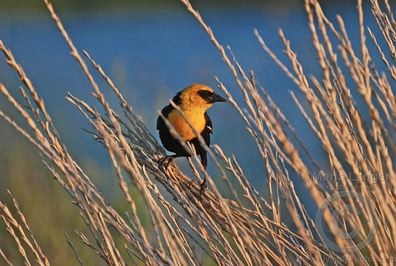
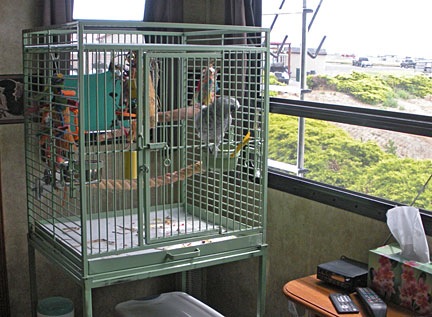 There’s a La-Z-Boy style rocker/recliner. (There were actually two, but we pulled one out to have room for Alex the Bird’s cage.) I never thought I’d like one, but I spend a lot of time in it. I sit here and blog or read in the morning with my coffee and sometimes do the same after I’ve covered Alex for the night. It’s right beside the big back window, so I can watch the world — or at least this part of it — go by.
There’s a La-Z-Boy style rocker/recliner. (There were actually two, but we pulled one out to have room for Alex the Bird’s cage.) I never thought I’d like one, but I spend a lot of time in it. I sit here and blog or read in the morning with my coffee and sometimes do the same after I’ve covered Alex for the night. It’s right beside the big back window, so I can watch the world — or at least this part of it — go by. I have an “office.” It’s a slide out with a desk and room for a chair. I’ve got drawers and cabinets to store my office stuff, so there’s not a lot of junk lying around. I brought along my 24″ iMac so I have all the same computing capabilities I have at home. And I managed to bring my color laser printer (what was I thinking?) and store it out of sight in a cabinet. There’s even a spot for my scanner. The office area even has two windows that look out over the golf course.
I have an “office.” It’s a slide out with a desk and room for a chair. I’ve got drawers and cabinets to store my office stuff, so there’s not a lot of junk lying around. I brought along my 24″ iMac so I have all the same computing capabilities I have at home. And I managed to bring my color laser printer (what was I thinking?) and store it out of sight in a cabinet. There’s even a spot for my scanner. The office area even has two windows that look out over the golf course.
